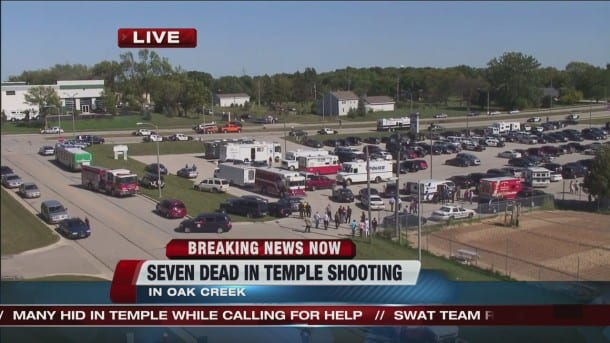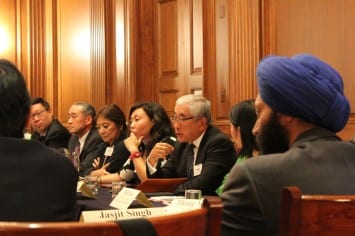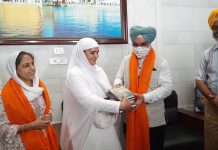WASHINGTON, D.C.—Thirteen years after the tragedy that shook the world, Sikhs in America are still trying to discover their identity in a multicultural, but fearful, America. While great strides have been made by Sikh organizations in the country, many Sikhs still look over their shoulder when in public places.
The fear arises from the mistaken belief by many Americans that turban wearers are Muslim—and an even more ignorant belief that Muslims are terrorists. This ignorance in general American society has led to everything from schoolyard bullying to mass murder at a Gurdwara. Sikhs have been targeted through beatings, shootings, stabbings, and road rage.



Historically, while the majority of acts of terror in the US were committed by Caucasians, the belief that an un-American bogeyman is out to kill Americans still prevails in the country—as it has for decades. The current bogeyman is the tall brown man wearing a turban.
Media and the government have not helped in this regard—images of turbaned Muslims flash on the screen when any major attack against the US takes place. In one famous case, Fox News showed Sikhs attending the Toronto area Dixie Gurdwara, labelling it a right-wing Mosque.
The backlash against Sikhs after 9/11 was swift, with Sikhs being shot down in cold blood as early as 3 days after the terrorist attack. Balbir Singh Sodhi was working with a landscaper at the Chevron Gas Station he owned near Phoenix, Arizona when he was attacked.
The murderer of Sodhi, Frank Silva Roque was a Boeing aircraft mechanic at a local repair facility. Roque held a criminal record for an attempted robbery in California, and had reportedly told friends and a waitress at a local Applebee’s restaurant that he was “going to go out and shoot some towel-heads” the day of the attacks. Roque, who apparently wanted revenge for September 11, mistook him for an Arab because of the clothes he wore, his turban, and his beard.
Within 25 minutes of Sodhi’s death, the Phoenix police reported four further attacks on people who either were Middle Easterners or who dressed with clothes thought to be worn by Middle Easterners. The backlash and violence continues to this day with reports of Sikhs being rounded up by street gangs and attacked.
Even the government “of the people” is culpable in continuing this misperception. The TSA, established after 9/11 to ensure aircraft safety, posts signs with pictures of brown, turbaned men in front of security screening areas at some airports, creating fear in passengers that the turbaned Sikhs in line might be one of “them.” In turn the turbaned Sikh feels fearful of being pulled aside by the TSA, and publicly made to feel ashamed for their identity.



Manpreet Singh, a US born Sikh, spoke with Sikh24 about his recent experience traveling, “Right when I got near the security line, there were these faces of global terrorism. I looked around and people were staring at me. Some tried to make nervous light talk with me. Then, when I refused to take my kara off, the TSA agent touched me very inappropriately all over my body while hundreds of people walked by and stared.”
“I was the only one being groped at the time, so I felt like people were commenting on who I was. They were accusing me with their stares,” he continued.
Sikhs are an integrated part of American society and are one of the most affluent groups in the country. But many Sikhs remember 9/11 as the day fellow Americans began to see them differently, in a dangerous way.
“In addition to the 9/11 attacks, the news coverage was very much disturbing. Instead of focusing on the plotters of the attack, international news media were rotating pictures of a selected few terrorists that happened to wear turbans,” said Prebhdev Singh, a California Sikh. “I was in high school at that time and it was my first year wearing a turban to school. You can just imagine a turbaned boy sitting in a class full of students, with the TV flashing pictures of those with similar appearance, and labeling them as terrorists. No one knew that Sikhs had nothing to do with these horrendous acts.”
In an NBC News editorial, Lakhpreet Kaur, Editor of Kaur Life and originally from Wisconsin, talks about her husband who wears a turban. She feels fearful when they are in public together, in case somebody may decide to attack him. “I feel the need to protect him the only way I can. I laugh a little louder at his jokes, smile and hold his hand, and hug him frequently. I try to humanize him in the public’s eye. I think, ‘If they see that he has a wife whom he loves very much, maybe they won’t shoot him.’ We’ve been safe. We haven’t been physically targeted.”
Expressing her patriotism, Lakhpreet Kaur continues, “This is my country. America is my home. I believe and live by American values. I was raised to respect my neighbors. To honor diversity and tolerance. To not attack people who don’t look or sound or pray like me.”
In recent years, organizations like SALDEF, Sikh Coalition, and United Sikhs have worked hard to educate Americans and specifically American law enforcement and governmental bodies about who Sikhs are. These organizations have urged law enforcement to vigorously pursue hate crime charges against those who commit acts against Sikhs.



“Our mission is to empower Sikh Americans by building dialogue, deepening understanding, promoting civic and political participation, and upholding social justice and religious freedom for all Americans. We are grounded in our values of optimism (chardi kala), humility (nimrata) and service (seva), inspired by the community (sangat) for the benefit of all (sarbat da bhalla),” said Jasjit Singh, Executive Director of SALDEF.
SALDEF has recently started a PR campaign with commercials showing Sikhs being normal people going about their normal, everyday lives. The television commercial starts with the famous Sikh American designer, Waris Ahluwalia saying, “For over 125 years, Sikhs have been part of the American culture. My name is Waris, and I’m proud to be an American.”
The hope is to combat the ignorance and xenophobia that has led to hate crimes against Sikhs. “We envision a United States where Sikh Americans are respected and recognized as a vibrant and integral part of the fabric of this nation and are appreciated for our shared values of service, social justice, and an unshakeable belief in freedom and equality for all,” he continued.
The fight to change the perception of Sikhs in America is also gaining ground in academia. In 2013, SALDEF partnered with Stanford University to conduct the first-ever national survey on the public perception of Sikhs. The study was called Turban Myths: The Opportunities and Challenges for Reframing Sikh American Identity in Post-9/11 America.
Jasjit Singh, speaking on the study, said it “corroborates, through literary review and data analysis, the existence of a specific cultural bias and its impact on the real, daily lived experiences of the Sikh American community. Key findings of the research include one out of five Americans experiences fear or apprehension when they see a Sikh American in a dastar and beard who is a stranger. The study also shows that media contributes to and fuels the bias against the Sikh articles of faith.”
“What Turban Myths demonstrated to Sikh Americans was that while our community represents the American dream, our neighbors still may not know us,” lamented Jasjit Singh. This is why they started the PR campaign in partnership with Comcast.
The importance of media has been stressed by Sikh organizations, such as Sikh24, more and more. Globally, social media, television, memes, print media, and other forms of media are known to be the way to change public perception of an issue. For years, the media has implied that the Sikh identity is one linked to Islamic terrorists. Now this is beginning to change.
“SALDEF’s day-to-day media work involves us generating media opportunities for Sikh American thinkers on issues impacting all Americans, whether it is SALDEF Board Member Jesse Kaur Bawa addressing the Redskins football team name, and standing up against racism in sports as well as SALDEF securing an opportunity for Lakhpreet Kaur to speak to NBCNews.com to discuss challenging facing Sikh Americans today, 13 years since the 9/11 tragedy,” said Jasjit Singh.
Early on, many Sikhs just wanted to take action, so that they aren’t targetted. Many groups were formed and began to compete. As each Sikh organization found its voice and its niche, cooperation began to grow. While there is still much to be desired, there has been a lot of great cooperation between the 3 large Sikh American civil rights groups recently, from educating law enforcement, to petitioning courts.
“Sikh American organizations work together to create change. To create change, different organizations can collaborate and not duplicate efforts when cultivating that change,” Jasjit Singh said. “When we study American history, we learn that in order to create long and meaningful change, one must make a lifetime commitment. In addition, Sikh values, including religious freedom for all and equality amongst genders, castes, creeds, is a mission that we must pass to future generations.”
This cooperation is what has begun to change the face of Sikh media and it is what will change the perception of Sikhs in America in the future.





